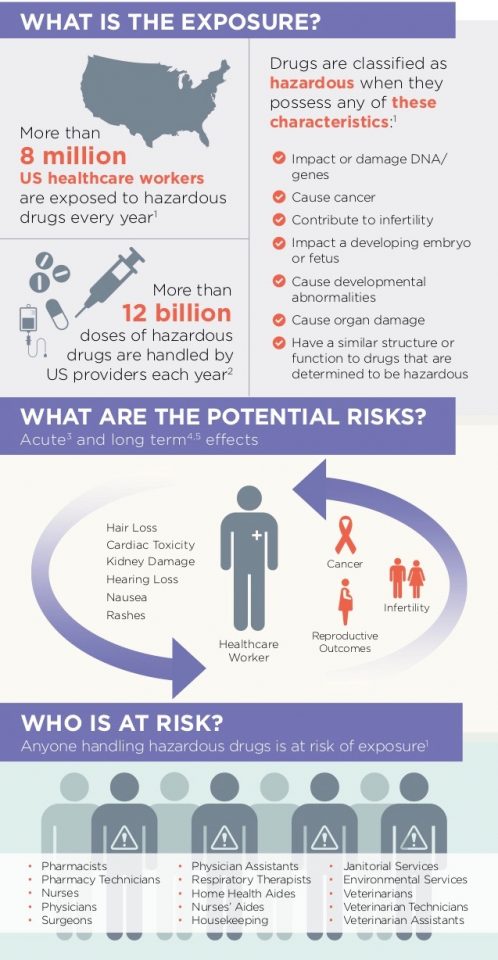The health risks of handling antineoplastic drugs (AD) are well established. Healthcare professionals such as pharmacists and nurses can be exposed while caring for cancer patients receiving AD therapies. In Canada, an estimated 75,000 workers are exposed to AD, including 22,900 pharmacy technicians (75% female), 20,500 nurses (90% female) and 20,000 pharmacists (60% female; CAREX, 2017). In the U.S. it is estimated that 5.5 million healthcare workers are engaged in cancer patient care, with the majority being nurses and pharmacists (Bureau of Labor Statistics, 2016).
AD exposures have been associated with adverse acute (National Institute for Occupational Safety and Health, 2004; McDiarmid & Egan, 1988), cardio-toxic (Lamberti et al., 2014), reproductive (Dranitsaris et al., 2005; Valanis et al., 1997; Valanis, Vollmer, & Steele, 1999) and genotoxic (McDiarmid et al., 2010; Testa et al., 2007) effects. Exposure sources are numerous, including drug delivery carriers, intravenous infusion bags, surfaces where contaminated bags are placed, floors in patient care and pharmacies (Graeve et al., 2017), and when proper removal procedures are not followed, contaminated gloves and gowns (Tomas et al., 2015). Studies conducted worldwide over the past two decades indicate widespread surface contamination (Connor et al., 2010). The majority of this research has been conducted outside North America (Connor, Zock, & Snow, 2016) and the potential health risks associated with low-level multi-agent exposure from contaminated surfaces remain poorly understood (Connor, Zock, & Snow, 2016). AD contamination is invisible and thus exposure may go undetected without purposeful investigation, typically through surface wipe or biomonitoring methods.
AD use is increasing globally as the number of cancer patients receiving treatment grows and as AD use in treating nonmalignant diseases expands. Healthcare workers’ exposures to these agents are thus likely to continue to increase as well (National Institute for Occupational Safety and Health, 2004). Occupational exposures likely affect a broader group of healthcare workers than previously thought; surface contamination is prevalent in multiple hospital departments (Hon, Barzan, & Astrakianakis, 2014) and AD residues were detected on healthcare workers’ hands that had no known direct AD contact. In fact, researchers reported that the highest proportion of samples came from individuals not involved in AD administration (e.g. volunteer, oncologist, ward aide, dietician) in that study (Hon, Barzan, & Astrakianakis, 2014).
Bureau of Labor Statistics. (2016). Occupational employment and wages, May 2016. Retrieved from https://www.bls.gov/news.release/archives/ocwage_03312017.pdf
CAREX Canada. (2017). CAREX Canada Annual Report 2016-2017. Retrieved from https://www.carexcanada.ca/CAREX_Annual_Report_2017.pdf
Connor, T. H., Debord, D. G., Pretty, J. R., Oliver, M. S., Roth, T. S., Lees, P. S. J., … Mcdiarmid, M. A. (2010). Evaluation of Antineoplastic Drug Exposure of Health Care Workers at Three University-Based US Cancer Centers. Journal of Occupational and Environmental Medicine, 52(10), 1019–1027. doi: 10.1097/jom.0b013e3181f72b63
Connor, T. H., Zock, M. D., & Snow, A. H. (2016). Surface wipe sampling for antineoplastic (chemotherapy) and other hazardous drug residue in healthcare settings: Methodology and recommendations. Journal of Occupational and Environmental Hygiene, 13(9), 658–667. doi: 10.1080/15459624.2016.1165912
Dranitsaris, G., Johnston, M., Poirier, S., Schueller, T., Milliken, D., Green, E., & Zanke, B. (2005). Are health care providers who work with cancer drugs at an increased risk for toxic events? A systematic review and meta-analysis of the literature. Journal of Oncology Pharmacy Practice, 11(2), 69–78. doi: 10.1191/1078155205jp155oa
Graeve, C. U., Mcgovern, P. M., Alexander, B., Church, T., Ryan, A., & Polovich, M. (2016). Occupational Exposure to Antineoplastic Agents. Workplace Health & Safety, 65(1), 9–20. doi: 10.1177/2165079916662660
Hon, C.-Y., Barzan, C., & Astrakianakis, G. (2014). Identification of Knowledge Gaps Regarding Healthcare Workers Exposure to Antineoplastic Drugs: Review of Literature, North America versus Europe. Safety and Health at Work, 5(4), 169–174. doi: 10.1016/j.shaw.2014.06.001
Lamberti, M., Porto, S., Zappavigna, S., Addeo, E., Marra, M., Miraglia, N., … Caraglia, M. (2014). A mechanistic study on the cardiotoxicity of 5-fluorouracil in vitro and clinical and occupational perspectives. Toxicology Letters, 227(3), 151–156. doi: 10.1016/j.toxlet.2014.03.018
McDiarmid, M., & Egan, T. (1988). Acute Occupational Exposure to Antineoplastic Agents. Journal of Occupational and Environmental Medicine, 30(12), 984–987. doi: 10.1097/00043764-198812000-00020
McDiarmid, M. A., Oliver, M. S., Roth, T. S., Rogers, B., & Escalante, C. (2010). Chromosome 5 and 7 Abnormalities in Oncology Personnel Handling Anticancer Drugs. Journal of Occupational and Environmental Medicine, 52(10), 1028–1034. doi: 10.1097/jom.0b013e3181f73ae6
National Institute for Occupational Safety and Health. (2004). Preventing Occupational Exposures to Antineoplastic and Other Hazardous Drugs in Health Care Settings. Retrieved from https://www.cdc.gov/niosh/docs/2004-165/pdfs/2004-165.pdf?id=10.26616/NIOSHPUB2004165
Testa, A., Giachelia, M., Palma, S., Appolloni, M., Padua, L., Tranfo, G., … Cozzi, R. (2007). Occupational exposure to antineoplastic agents induces a high level of chromosome damage. Lack of an effect of GST polymorphisms. Toxicology and Applied Pharmacology, 223(1), 46–55. doi: 10.1016/j.taap.2007.05.006
Tomas, M. E., Kundrapu, S., Thota, P., Sunkesula, V. C. K., Cadnum, J. L., Mana, T. S. C., … Donskey, C. J. (2015). Contamination of Health Care Personnel During Removal of Personal Protective Equipment. JAMA Internal Medicine, 175(12), 1904. doi: 10.1001/jamainternmed.2015.4535
Valanis, B., Vollmer, W., Labuhn, K., & Glass, A. (1997). Occupational Exposure to Antineoplastic Agents and Self-Reported Infertility Among Nurses and Pharmacists. Journal of Occupational & Environmental Medicine, 39(6), 574–580. doi: 10.1097/00043764-199706000-00013
Valanis, B., Vollmer, W. M., & Steele, P. (1999). Occupational Exposure to Antineoplastic Agents: Self-Reported Miscarriages and Stillbirths Among Nurses and Pharmacists. Journal of Occupational and Environmental Medicine, 41(8), 632–638. doi: 10.1097/00043764-199908000-00004
